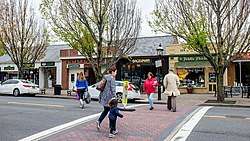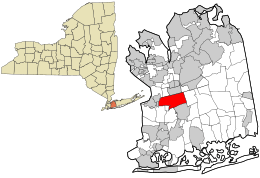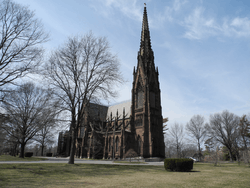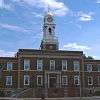Garden City, New York
Garden City is an incorporated village in Nassau County, New York, United States, in the town of Hempstead. It was founded by multi-millionaire Alexander Turney Stewart in 1869, and is on Long Island, to the east of New York City, 18.5 miles (29.8 km) from midtown Manhattan. The village is located mostly in the Town of Hempstead with a small portion in the Town of North Hempstead.[3]
Garden City, New York | |
|---|---|
| Incorporated Village of Garden City | |
 Downtown Garden City | |
 Location in Nassau County and the state of New York | |
 Garden City Location within the state of New York  Garden City Garden City (the United States) | |
| Coordinates: 40°43′37″N 73°38′59″W | |
| Country | United States |
| State | New York |
| County | Nassau |
| Area | |
| • Total | 5.35 sq mi (13.86 km2) |
| • Land | 5.33 sq mi (13.80 km2) |
| • Water | 0.03 sq mi (0.06 km2) |
| Elevation | 89 ft (27 m) |
| Population (2010) | |
| • Total | 22,371 |
| • Estimate (2019)[2] | 22,454 |
| • Density | 4,213.55/sq mi (1,626.98/km2) |
| Time zone | UTC-5 (Eastern (EST)) |
| • Summer (DST) | UTC-4 (EDT) |
| ZIP codes | 11530 |
| Area code(s) | 516 |
| FIPS code | 36-28178 |
| GNIS feature ID | 0950875 |
| Website | www |
As of the 2010 census, Garden City's population was 22,371.[4]
The Garden City name is applied to several other unincorporated, nearby jurisdictions, as well. In the region, hamlets such as Garden City South, Garden City Park, and East Garden City are located next to the incorporated village of Garden City, but are not themselves part of it. Roosevelt Field, the shopping center and raceway built on the former airfield from which Charles Lindbergh took off on his landmark 1927 transatlantic flight in the Spirit of St. Louis, is located in East Garden City. Adelphi University's main campus is in Garden City.
History
Early years

In 1869, the Irish-born millionaire Alexander Turney Stewart bought a portion of the lightly populated Hempstead Plains. In a letter, Stewart described his intentions for Garden City:
Having been informed that interested parties are circulating statements to the effect that my purpose in desiring to purchase the Hempstead Plains is to devote them to the erection of tenement houses, and public charities of a like character, etc. I consider it proper to state that my only object in seeking to acquire these lands is to devote them to the usual purposes for which such lands, so located, should be applied that is, open them by constructing extensive public roads, laying out the lands in parcels for sale to actual settlers, and erecting at various points attractive buildings and residences, so that a barren waste may speedily be covered by a population desirable in every respect as neighbour taxpayers and as citizens. In doing this I am prepared and would be willing to expend several millions of dollars.[5]
The central attraction of the new community was the Garden City Hotel, designed by the acclaimed firm of McKim, Mead & White. Although the original structure, as well as that which replaced it at the end of the 19th century, were torn down years ago after a fire, a rebuilt hotel still stands on the original grounds, as do many nearby Victorian homes. Access to Garden City was provided by the Central Railroad of Long Island, another Stewart project which he undertook at the same time. The railroad's Hempstead Branch opened in 1873.
Stewart's wife, Cornelia, founded the St. Paul's School for boys, St. Mary's School for girls, a Bishop's Residence and the Gothic Cathedral of the Incarnation, which is today the center of the Episcopal Diocese of Long Island, as well as the final resting place of Alexander Turney Stewart and Cornelia Stewart. This elaborate memorial was completed in 1885. Mrs. Stewart died the following year. In 2008, the Cathedral of the Incarnation underwent a multimillion-dollar renovation and rehabilitation project, which was completed in 2012.
Voters selected Mineola (in the town of North Hempstead) to be the county seat for the new county of Nassau in November 1898[6] (before Mineola incorporated as a village in 1906 and set its boundaries), winning out over Hicksville and Hempstead.[7] The Garden City Company (founded in 1893 by the heirs of Alexander Turney Stewart)[8] donated four acres of land for the county buildings just south of the Mineola train station and the present-day village of Mineola, in the town of Hempstead.[9][10] The land and the buildings have a Mineola postal address, but are within the present-day village of Garden City,[11] which did not incorporate, or set its boundaries, until 1919. The early village did well due to its proximity to Hempstead, which was at that time the commercial center of Long Island. In time, thanks to the railroad and to automobiles, as well, Garden City’s population increased.
20th century
In 1910, Doubleday, Page, and Co., one of the world's most important publishers, moved its operations, which included its own train station, to Garden City.[12] The Doubleday company purchased much of the land on the west site of Franklin Avenue, and built estate homes for many of its executives on Fourth Street. In 1916, company co-founder and Garden City resident Walter Hines Page was named Ambassador to Great Britain.
In 1915, the village of Garden City merged with the village of Garden City Estates to its west. It became an incorporated village in 1919. Garden City’s growth promoted the development of many nearby towns, including Stewart Manor, Garden City Park, Garden City South and East Garden City.
In the 1920s, the community continued to grow, with houses built in Garden City Estates as well as the eastern section of Garden City. This development included the Mott Section, developed by the heirs to the Mott's apple juice fortune, which was spurred by easy access to the now-defunct Long Island Motor Parkway, as well as the establishment of the Doubleday publishing group’s corporate headquarters. Doubleday's headquarters, known as Country Life Press, remained in Garden City until Bertelsmann took over the firm in the mid-1980s. The plant closed in 1988 and has been converted to offices for Bookspan, a media firm partly owned by Doubleday.
In 1927, Charles Lindbergh departed on his famous solo transatlantic flight from Roosevelt Field in East Garden City.
Housing construction slowed after the 1929 stock market crash. But in the 1930s, hundreds of houses were built to accommodate a population boom, though Garden City used a strict zoning code to preserve Stewart’s vision. Alone in central Nassau, the village retained a sense of orderly development, true to its rigorously planned roots. Mitchel Air Force Base, on the far east side of Garden City, served as a United States Air Force base from 1918 through 1961. As of 2008, the U.S. military still retained a limited physical presence, with the rest of the base occupied by housing, Hofstra University, Nassau Community College, the Long Island Children’s Museum, the Nassau County Firefighters Museum and Education Center, a Sony IMAX theater and the Cradle of Aviation Museum.
After World War II, following a trend of urban residents moving to the suburbs, Garden City continued to grow. Post-war construction filled out the present borders of Garden City with many split-level and ranch-style homes, with construction occurring in the town's far eastern, northern and western sections. The Waldorf School of Garden City was founded in 1947 (one of the first Waldorf schools in the United States), originally as a part of Adelphi University. The village's public high school was also constructed during this time.
In the 1970s, the old Garden City Hotel declared bankruptcy, and subsequently closed. The hotel was later demolished, and Garden City lost one of its grandest and most historical landmarks. A new Garden City Hotel was constructed on the site of the old Garden City Hotel. In 1978, 50 of the original structures collectively known as the A. T. Stewart Era Buildings were designated a national historic district and listed on the National Register of Historic Places.[13]
In 1989, the St. Paul's School also closed and in 1993 was purchased by the Village of Garden City. Recently, the village voted to designate St. Paul's and its property as "park land". St. Mary's School, the sister school of St. Paul's, was demolished in 2002. Since then, six large single-family houses have been built on the property.
In the late 1990s and early 2000s, the village's downtown areas (New Hyde Park Road, Seventh Street and Franklin Avenue) benefited from an urban renewal campaign and new construction. Bloomingdale's has moved from Franklin Avenue to the Roosevelt Field shopping mall. Lord & Taylor has a large freestanding location that opened in 1956 on Franklin Avenue, which is still there today. Sears now occupies the building that was once home to Bloomingdale's. Several luxury restaurants have also opened in recent years along this avenue.
On December 7, 1993, the city's Merillon Avenue station was the location of the Long Island Rail Road massacre in which six people were murdered and 19 injured in a racially motivated mass shooting perpetrated by Colin Ferguson, a black Jamaican immigrant.[14]
Geography

According to the United States Census Bureau, the village has a total area of 5.3 square miles (13.8 km2), all of it land. The village lost some territory between the 1990 census and the 2000 census.[15]
Greater Garden City area
In addition to the Village of Garden City, the Garden City 11530 ZIP code includes another incorporated village, Stewart Manor, and two unincorporated areas of the Town of Hempstead, Garden City South and East Garden City.
Demographics
| Historical population | |||
|---|---|---|---|
| Census | Pop. | %± | |
| 1880 | 574 | — | |
| 1920 | 2,420 | — | |
| 1930 | 7,180 | 196.7% | |
| 1940 | 11,223 | 56.3% | |
| 1950 | 14,486 | 29.1% | |
| 1960 | 23,948 | 65.3% | |
| 1970 | 25,373 | 6.0% | |
| 1980 | 22,927 | −9.6% | |
| 1990 | 21,686 | −5.4% | |
| 2000 | 21,672 | −0.1% | |
| 2010 | 22,371 | 3.2% | |
| Est. 2019 | 22,454 | [2] | 0.4% |
| U.S. Decennial Census[16] | |||
As of 2010, approximately 40% of Garden City residents identified themselves of being of Irish descent.[17][18][19]
As of the census[20] of 2010, 21,811 people lived in Garden City. The population density was 4,059.5 inhabitants per square mile (1,567.0/km2). The town included 7,555 housing units at an average density of 1,415.2 per square mile (546.3/km2). The racial makeup of the village was 88.1% White, 1.2% African American, 0.1% Native American, 5.0% Asian, 0.00% Pacific Islander, 0.4% from other races, and 0.8% from two or more races. Hispanic or Latino of any race were 6.0% of the population.
Garden City included 7,386 households, out of which 36.1% had children under the age of 18 living with them, 69.8% were married couples living together, 7.5% had a female householder with no husband present, and 20.7% were non-families. 19.2% of all households were made up of individuals, and 12.0% had someone living alone who was 65 years of age or older. The average household size was 2.83 and the average family size was 3.27.
In the village, the population was spread out, with 26.5% under the age of 18, 4.7% from 20 to 24, 7.2% from 25 to 34, 42.6% over 45, 21.6% over 60 and 1.9% who were over the age of 85. The median age was 41 years. For every 100 females, there were 90.5 males. For every 100 females age 18 and over, there were 84.1 males.
According to a 2007 estimate,[21] the median income for a household in the village was $112,854, and the median income for a family was $131,717. The per capita income for the village was $53,196. The average earnings for a full-time year round male is $93,144 and for a full-time year around female the average earning is $49,954. About 104 families and 476 individuals were below the poverty line, including 2.3% of those under age 18 and 2.6% of those age 65 or over.
Transportation
There are four Long Island Rail Road (LIRR) train stations in the village. The stops are Stewart Manor, Nassau Boulevard, Garden City and Country Life Press on the LIRR Hempstead Branch. There are additional stops on the LIRR Main Line just over the Garden City border at New Hyde Park, Merillon Avenue, and Mineola. Additionally, several bus lines traverse the village provided by NICE bus (formerly MTA Long Island bus).
Education
Garden City is served by its own school district. There are seven schools in the Garden City School District: three primary schools (Hemlock School, Homestead School and Locust School), two elementary schools (Stewart School and Stratford School), the Garden City Middle School (grades 6–8), and finally, the Garden City High School (grades 9–12). The primary schools function as a single unit, with three campuses spread across the village.
| School | Grades |
|---|---|
| Hemlock School | K–1 |
| Homestead School | K–1 |
| Locust School | K–1 |
| Stewart School | 2–5 |
| Stratford School | 2–5 |
| Garden City Middle School | 6–8 |
| Garden City High School | 9–12 |
Private schools
One independent school, the Waldorf School of Garden City (grades pre-K–12), and two Roman Catholic elementary schools (K–8), St. Joseph School and St. Anne School, are in Garden City. The former St. Paul's School and St. Mary's School are now defunct.
Higher education
In 1929, Adelphi College, which later became Adelphi University, moved from Brooklyn to its present 76-acre (31 ha) campus in Garden City, becoming the first four-year college in Nassau or Suffolk counties.
The State University of New York (SUNY) Nassau Community College mailing address is located in Garden City.
Notable landmarks
- Adelphi University
- Apostle Houses
- Cathedral of the Incarnation
- Endo Pharmaceuticals Building by Paul Rudolph
- Mitchel Air Force Base, also known as Mitchel Field
- St. Paul's School
- Garden City Middle School
- Garden City High School
- Garden City Hotel
Legacy
Place names

Garden City inspired the names of several nearby municipalities (as stated above), and is the namesake of Garden Village, Kentucky.[22]
Notable people
- Herbert M. Allison, businessman
- Eddie Arcaro, 1916–1997, jockey
- Jason Blake, NHL All-Star
- Steven Chu, Secretary of Energy, Nobel Prize winner[23]
- Cliff Compton, former WWE Tag Team Champion and current Ring of Honor wrestler
- Bruce Coslet, former New York Jets head coach
- Matt Daley, New York Yankees pitcher
- Dave DeBusschere, NBA Hall of Famer[24]
- Nelson DeMille, author[25]
- Kent Desormeaux, jockey
- Mick Foley, professional wrestler
- John Gibson, journalist
- Kemp Hannon, New York state senator[26]
- Liza Huber, soap opera actress, Passions
- Joe Iconis, musical theater writer
- Dave Jennings, former New York Giants punter
- Greg Kelly, television anchor
- Harvey J. Levin, pioneer of communications economics, holder of Long Island's first research chair, Hofstra University[27][28]
- Susan Lucci, actress; grew up in Garden City, worked at the Garden City Hotel, and in 1978 moved back to Garden City[29]
- Eric Mangini, former New York Jets coach
- Christopher Masterson, actor
- Danny Masterson, actor
- Kevin Mawae, former NFL Pro Bowl center and president of NFL Player's Association
- Kiaran McLaughlin, horse trainer
- Jennifer McLogan, TV news reporter
- Connell McShane, Fox Business Network
- Richard Migliore, horse jockey
- Alexandra Miller, Florida politician and businesswoman
- Joe Mohen, Internet entrepreneur
- Bill Moyers, journalist
- Elliott Murphy, singer-songwriter[30]
- Walter Hines Page, United States Ambassador to England during World War I, and co-founder of Doubleday, Page and Co. publishing
- Žigmund Pálffy, four-time NHL All-Star
- Mark Parrish, NHL All-Star
- Larry Pasquale, former special teams coach for the New York Jets
- Ethan Phillips, television actor, Star Trek: Voyager[31]
- Denis Potvin, NHL All-Star
- Kathleen Rice 4th District of New York Representative; grew up in Garden City on Nassau Boulevard
- Telly Savalas, actor[32]
- Dennis Seidenberg, two-time Stanley Cup Champion [33]
- Leslie Segrete, Trading Spaces carpenter, designer
- Lara Spencer, TV host
- Mark Streit, NHL All-Star
- Johnny Sylvester (1915–1990) received as a seriously ill child a promise from Babe Ruth that Ruth would hit a home run in the 1926 World Series on his behalf.[34]
- John Tesh, musician, news anchor
- William B. Turner, World War I hero, recipient of the Medal of Honor[35][36]
- Chris Weidman, UFC fighter
- Paul Zaloom, actor and puppeteer best known as Beakman on Beakman's World
In popular culture
- The film The Spirit of St. Louis (1957), starring James Stewart, features Charles Lindbergh's historical flight to Paris from Roosevelt Field in Garden City in 1927. Its first few scenes occur at the Garden City Hotel, where Lindbergh had a room reserved (but did not use, contrary to the film's portrayal), and the press corps stayed who were covering the event spent the night prior to his flight;[37] Lindbergh was up all night working on his plane the night before the flight,[38] although he did have dinner and take a nap at the Garden City home of his friend, Gregory J. Brandewiede, at 105 Third Street. The opening shot of the film's first scene shows the hotel's front exterior and sign. Subsequent scenes take place[37] and were filmed at[39][40] Roosevelt Field.
- Musician John Tesh's fourth album, released in 1989, is titled Garden City (Cyprus Records), an homage to his hometown, and includes a song with the same title.[41] The record company he created in 1995 and currently owns is Garden City Records.
Films
- Boiler Room (2000)
- Election (1999)
- Frankenstein Meets the Space Monster (1965)
- Santa Claus Conquers the Martians (1964)
- Storytelling (2001)
- Street of the Dead (2008)
- The Antics of Ann (1917)
- The Godfather (1972)
- The Judgment of Weeping Mary (2008)
- The Spirit of St. Louis (1957)[39][40]
See also
References
- "2019 U.S. Gazetteer Files". United States Census Bureau. Retrieved July 27, 2020.
- "Population and Housing Unit Estimates". United States Census Bureau. May 24, 2020. Retrieved May 27, 2020.
- "List of Incorporated Villages in the Town of North Hempstead". Town of North Hempstead. Archived from the original on 2010-04-26. Retrieved 2010-06-07.
- U.S. Census Bureau. "Race, Hispanic or Latino, Age, and Housing Occupancy: 2010 Census Redistricting Data (Public Law 94-171) Summary File (QT-PL), Garden City village, New York". United States Census Bureau. Retrieved October 3, 2011.
- Alexander Turney Stewart, Letter to the Editor, Hempstead Sentinel, 6th July 1869, quoted in C. B. Purdom, ed., Town Theory and Practice, London: Benn Brothers, 1921, p. 16-17
- "Mineola Chosen Nassau County's Seat". New York Times. 1898-11-10. Retrieved 2010-06-06.
- "County of Nassau Elections". New York Times. 1898-09-01. Retrieved 2010-06-06.
- "Incorporated Village of Garden City: History". Incorporated Village of Garden City. Archived from the original on 2011-07-19. Retrieved 2010-06-06.
- "Sites for Nassau County Buildings". New York Times. 1898-09-29. Retrieved 2010-06-06.
- "The History of Nassau's County Seat". rootsweb. Retrieved 2010-06-06.
- Fischler, Marcelle S (1998-11-15). "An Immigrant's Vision Created Garden City". The New York Times. Retrieved 2010-06-06.
- Newportvintagebooks.com
- "National Register Information System". National Register of Historic Places. National Park Service. March 13, 2009.
- N.Y. Train Killings Suspect Was 'Motivated By Bias' - The Washington Post
- "New York: 2000 Population and Housing Unit Counts" (PDF). September 2003. p. III-9. Retrieved 2010-12-22.
- "Census of Population and Housing". Census.gov. Retrieved June 4, 2015.
- United States Census 2010
- Garden City Life, August 28, 2015 page 3
- NerdWallet Analysis of 2010 Census Data https://www.nerdwallet.com/blog/cities/lifestyle/most-irish-new-york-2015/
- "U.S. Census website". United States Census Bureau. Retrieved 2008-01-31.
- U.S. Census Bureau - Garden City village, NY
- Rennick, Robert (1987). Kentucky Place Names. Lexington: University Press of Kentucky. p. 113. Retrieved 1 Aug 2013.
- Kerr, Kathleen (July 16, 2008). "They Began Here". Newsday. Archived from the original on December 14, 2008. Retrieved 2008-09-17.
- Goldstein, Richard (May 15, 2003). "Dave DeBusschere, 62, Relentless Forward On Knicks' Championship Teams, Is Dead". New York Times. Retrieved 2009-10-28.
- Strickland, Carol (April 8, 1990). "Novelist Uses the Island's Gold Coast as a Setting For a Clash of Cultures". The New York Times.
- "Sen. Kemp Hannon (R-New York) biography". New York Library Association.
- "Harvey J. Levin, 67, Economics Professor". The New York Times. May 5, 1992.
- Lander, Estelle (May 4, 1992). "Obituaries: Harvey Joshua Levin, Professor at Hofstra". Newsday.
- La Gorce (March 18, 2011). "Arts/Long Island: All About the Woman Behind Erica Kane". The New York Times. Retrieved November 26, 2013.
- Murphy, Elliott. "My Many Hometowns..." elliottmurphy.com. Retrieved October 28, 2009.
- "Ethan Phillips". IMDb.
- "About". tellysavalas.com. Retrieved 2009-10-28.
- https://www.facebook.com/dennis.seidenberg.5. Missing or empty
|title=(help) - Thomas, Robert McG. Jr. (January 11, 1990). "Johnny Sylvester, the Inspiration For Babe Ruth Heroics, Is Dead". The New York Times. Retrieved June 28, 2009.
- "Gravesites: Turner, William B." Home of Heroes.
- "Valor: Recipients". Military Times.
- Film: The Spirit of St. Louis, directed by Billy Wilder, released April 20, 1957.
- New York Times, May 20, 1962 https://www.nytimes.com/books/98/09/27/specials/lindbergh-plane.html
- Wikipage: The Spirit of St. Louis (film), Production paragraph 3.
- Phillips, Gene D., Some Like It Wilder: The Life and Controversial Films of Billy Wilder (Screen Classics). Lexington, Kentucky: The University Press of Kentucky, 2009, pp. 180-183.
- Chicago Tribune, "John Tesh: Garden City", November 2, 1989.
External links
| Wikimedia Commons has media related to Garden City, New York. |
| Wikivoyage has a travel guide for Garden City (New York). |
